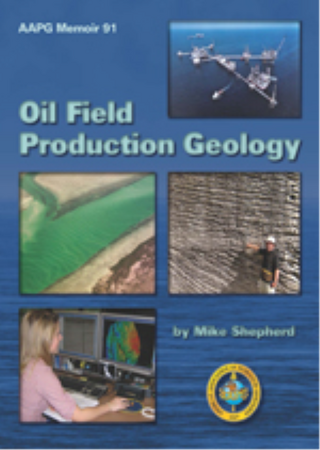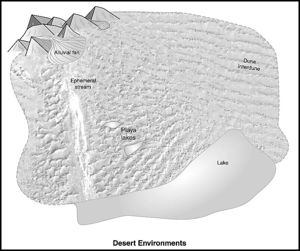Eolian reservoirs
This page is under development
| Oil Field Production Geology | |

| |
| Series | Memoirs |
|---|---|
| Part | The Production Geologist and the Reservoir |
| Chapter | Eolian reservoirs |
| Author | Mike Shepherd |
| Link | Web page |
| PDF file (requires access) | |
| Store | AAPG Store |
Eolian sediments comprise desert sediments and coastal sand dunes, much of which are wind deposited. They can form thick and laterally extensive sandstone reservoirs. Eolian sandstone reservoirs are commonly found in two time intervals in the geological record, the early Paleozoic and between the Permian and the Early Jurassic.[1]
Eolian lithofacies associations
Eolian lithofacies associations include dune, interdune, fluvial, and sabkha environments (Figure 1). Dunes form where large volumes of dry sand are blown across the landscape. Lying between the dunes are the interdune areas, which are flat-lying belts or depressions. These areas may be subjected to either erosion or deposition. In wetter conditions, alluvial fans may extend outwards from upland areas, and fluvial sediments can be deposited by ephemeral streams. Large damp to wet areas between the dunes may dry out to form flat-lying evaporitic crusts called sabkhas. Playa lakes are desert lakes that episodically dry out.
Several different dune types are found in deserts. They can form as crescentic dunes (including barchan dunes), as long linear dunes, or as star dunes with crest lines radiating from one or two central peaks. Different dune types may be superimposed to form complex dunes, whereas the same type of dune is superimposed to form compound dunes. The term draa has been used to refer to large compound or complex dunes.[2]
In deserts, dune sediments aggrade laterally and vertically as large-scale sand blankets. These may be very thick (more than 300 m [1000 ft]), and cover hundreds of square kilometers.[3] Internally, dunes comprise thick, cross-bedded intervals of well-rounded, well-sorted sandstones. They are normally the most productive lithofacies in eolian reservoir systems. Flatter-lying eolian sand sheets may be found along the margins of dune systems.[4]
Interdune and fluvial sediments generally show poorer reservoir characteristics by comparison to dune lithofacies. They are poorly sorted and are more likely to contain evaporite cements. Intercalated fine-grained sand and silt laminations together with diagenetic cementation tend to produce reservoir intervals with very poor vertical permeability. Nagtegaal[5] used multivariate analysis to determine the factors controlling the porosity of eolian sediments from the Permian of the southern North Sea. He found that the main control on porosity is grain sorting, which varies from well sorted in dune sandstones to less well sorted in the other associated sediments. The relationship between original sedimentary texture and porosity has survived even after extensive diagenesis. The very poor permeability characteristics of interdune sediments are commonly reported. Lindquist[6] found a contrast in permeability of four to five orders of magnitude between interdune and dune deposits in the Nugget Sandstone of southwestern Wyoming.
See also
- [[
- [[
- [[
References
- ↑ Cite error: Invalid
<ref>tag; no text was provided for refs namedNorth_1985 - ↑ Cite error: Invalid
<ref>tag; no text was provided for refs namedKocurek_1996 - ↑ Cite error: Invalid
<ref>tag; no text was provided for refs namedRichardsonetal_1988a - ↑ Cite error: Invalid
<ref>tag; no text was provided for refs namedKocurekandnielson_1986 - ↑ Cite error: Invalid
<ref>tag; no text was provided for refs namedNagtegaal_1979 - ↑ Cite error: Invalid
<ref>tag; no text was provided for refs namedLindquist_1983
